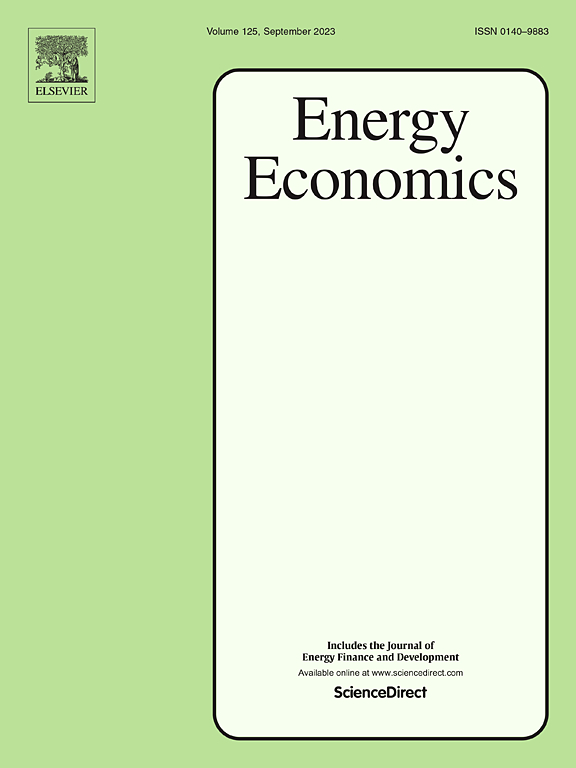Under the sustainable development goals: A research on the coupling coordination relationship of water- energy- food globally
IF 14.2
2区 经济学
Q1 ECONOMICS
引用次数: 0
Abstract
Under the backdrop of the Sustainable Development Goals (SDGs), the research on the coupling coordination relationship of water-energy-food (WEF), as an essential factor for human survival and development, has become a focal point. In this paper, through the understanding of SDG 2 (food), SDG 6 (water) and SDG 7 (energy), an indicator system is established, and entropy weighting, hierarchical analysis, coupling coordination degree model and exploratory spatio-temporal data analysis are adopted to analyze the coupling coordination degree (CCD) of WEF in 112 countries worldwide from 2000 to 2021 in a spatio-temporal manner. The relevant results show that: (1) The global water, energy and food systems all show different degrees of increase. The energy system scores the highest and provides a central driving force for the WEF's CCD evolution. (2) The global CCD of WEF rises slowly. Countries like the United States and China are in the front of the CCD, and Afghanistan and Rwanda are lagging behind in the WEF coupling status. In high-income countries, the CCD is higher and more volatile; in lower-middle-income and low-income countries, the CCD is lower and the “latecomer advantage” is significant. From the regional perspective, the CCD from high to low are South America, Europe, Oceania, North America, Asia and Africa. (3) The CCD is highly space-dependent, maintaining a basically unchanged spatial pattern. The spatial aggregation effect of CCD is obvious, and over 90 % of nations have not experienced any changes in the spatio-temporal transfer. According to the findings, policy recommendations such as constructing a global synergistic governance framework and strengthening the multilateral cooperation mechanism are proposed, with a view to promoting the rational allocation of resources on a global scale, realizing the goal of sustainable development and the long-term development of human society.
可持续发展目标下的全球水-能-粮耦合协调关系研究
在可持续发展目标(SDGs)的背景下,水-能-食物(WEF)作为人类生存和发展的重要因素,其耦合协调关系的研究成为人们关注的焦点。本文通过对可持续发展目标2(粮食)、可持续发展目标6(水)和可持续发展目标7(能源)的理解,建立指标体系,采用熵权法、层次分析法、耦合协调度模型和探索性时空数据分析,对2000 - 2021年全球112个国家的世界经济论坛耦合协调度(CCD)进行时空分析。结果表明:(1)全球水、能源和粮食系统均呈现不同程度的增长。能源系统得分最高,为世界经济论坛CCD的发展提供了核心驱动力。(2)世界经济论坛全球CCD上升缓慢。像美国和中国这样的国家在CCD的前面,阿富汗和卢旺达在WEF的耦合地位上落后。在高收入国家,CCD更高,也更不稳定;在中低收入和中低收入国家,CCD较低,“后发优势”显著。从区域来看,CCD从高到低依次为南美、欧洲、大洋洲、北美、亚洲和非洲。(3) CCD具有高度的空间依赖性,保持基本不变的空间格局。CCD的空间聚集效应明显,超过90%的国家没有发生时空转移变化。根据研究结果,提出了构建全球协同治理框架、加强多边合作机制等政策建议,以期促进全球范围内资源的合理配置,实现可持续发展目标和人类社会的长远发展。
本文章由计算机程序翻译,如有差异,请以英文原文为准。
求助全文
约1分钟内获得全文
求助全文
来源期刊

Energy Economics
ECONOMICS-
CiteScore
18.60
自引率
12.50%
发文量
524
期刊介绍:
Energy Economics is a field journal that focuses on energy economics and energy finance. It covers various themes including the exploitation, conversion, and use of energy, markets for energy commodities and derivatives, regulation and taxation, forecasting, environment and climate, international trade, development, and monetary policy. The journal welcomes contributions that utilize diverse methods such as experiments, surveys, econometrics, decomposition, simulation models, equilibrium models, optimization models, and analytical models. It publishes a combination of papers employing different methods to explore a wide range of topics. The journal's replication policy encourages the submission of replication studies, wherein researchers reproduce and extend the key results of original studies while explaining any differences. Energy Economics is indexed and abstracted in several databases including Environmental Abstracts, Fuel and Energy Abstracts, Social Sciences Citation Index, GEOBASE, Social & Behavioral Sciences, Journal of Economic Literature, INSPEC, and more.
 求助内容:
求助内容: 应助结果提醒方式:
应助结果提醒方式:


